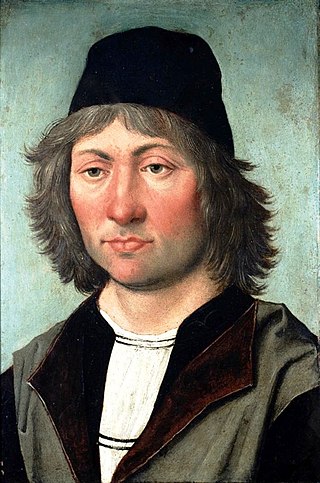
León is the second largest city in Nicaragua, after Managua. Founded by the Spanish as Santiago de los Caballeros de León, it is the capital and largest city of León Department. As of 2021, the municipality of León has an estimated population of 212,504.

The Cathedral of Saint Mary of Burgos is a Catholic church dedicated to the Virgin Mary located in the historical center of the Spanish city of Burgos. Its official name is Santa Iglesia Catedral Basílica Metropolitana de Santa María de Burgos.

The Spanish Renaissance was a movement in Spain, emerging from the Italian Renaissance in Italy during the 14th century, that spread to Spain during the 15th and 16th centuries.

Alonso González de Berruguete was a Spanish painter, sculptor and architect. He is considered to be the most important sculptor of the Spanish Renaissance, and is known for his emotive sculptures depicting religious ecstasy or torment.

Pedro Berruguete was a Spanish painter whose art is regarded as a transitional style between gothic and Renaissance art. Berruguete most famously created paintings of the first few years of the Inquisition and of religious imagery for Castilian retablos. He is considered by some as the first Renaissance painter in Spain.

Spanish art has been an important contributor to Western art and Spain has produced many famous and influential artists including Velázquez, Goya and Picasso. Spanish art was particularly influenced by France and Italy during the Baroque and Neoclassical periods, but Spanish art has often had very distinctive characteristics, partly explained by the Moorish heritage in Spain, and through the political and cultural climate in Spain during the Counter-Reformation and the subsequent eclipse of Spanish power under the Bourbon dynasty.

Cabranes is a municipality in the Autonomous Community of the Principality of Asturias. Some Towns of cabranes are: Santolaya, Torazu, Fresnéu, Graméu, Pandenes, Viñón, Niao, Arboleya, etc. It is bordered on the north by Villaviciosa, on the south by Piloña and Nava, on the east by Piloña and Villaviciosa and on the west by Villaviciosa y Nava.

Santa Maria del Campo is a town and municipality in the Province of Burgos, Spain. The village is in the wine region known as Ribera del Arlanza, 22 km from Lerma.
The decade of the 1490s in art involved some significant events.

Mascaraque is a municipality located in the province of Toledo, Castile-La Mancha, Spain. According to the 2006 census (INE), the municipality had a population of 550 inhabitants.

Llerena is a municipality located in the province of Badajoz, Extremadura, Spain. According to the 2007 census (INE), the municipality has a population of 5,995 inhabitants. Llerena, a town that declared itself a Historical Artistic gathering on December 29, 1966, is located in southwestern Spain. The head of the judicial and economic center of the region of the country of the same name, it is equidistant from 20 municipalities, and sits at the confluence of the District 432 and 413 National Roads.

Nava de Roa is a municipality and town located in the municipality of Ribera del Duero, province of Burgos, Castile and León, Spain. It is located 92 km from Burgos, 26 km from Aranda de Duero, and 70 km from Valladolis. According to the 2004 census (INE), the municipality has a population of 246 inhabitants.

The "National Museum of Sculpture" is a museum in Valladolid, Spain, belonging to the Spanish Ministry of Culture. The museum has an extensive sculptural collection ranging from the Middle Ages to the 19th century. The collections come mostly from churches and monasteries in the Region of Castile, whose pieces of religious art were confiscated by the State in 1836, by order of Minister of Finance Mendizábal. Other parts of the collections come from particular donations, deposits or acquisitions by the State.

Felipe Bigarny, also known as Felipe Vigarny, Felipe Biguerny or Felipe de Borgoña, etc. and sometimes referred to as El Borgoñón, was a sculptor born in Burgundy (France) but who made his career in Spain and was one of the leading sculptors of the Spanish Renaissance. He was also an architect.

The Cathedral of the Assumption of Mary, also known as the "Royal and Renowned Basilica Cathedral of the Assumption of the Blessed Virgin Mary", is a significantly important and historic landmark in León, Nicaragua. The cathedral was awarded World Heritage Site status with the United Nations Educational, Scientific and Cultural Organization (UNESCO). The site's nomination is Nicaragua's third cultural landmark, following the ruins of León Viejo and El Güegüense.

Spanish Romanesque designates the Romanesque art developed in the Hispanic-Christian kingdoms of the Iberian Peninsula in the 11th and 12th centuries. Its stylistic features are essentially common to the European Romanesque although it developed particular characteristics in the different regions of the peninsula. There is no Romanesque art in the southern half of the peninsula because it remained under Muslim rule (Al-Andalus). The examples of Romanesque buildings in the central area of the peninsula are sparse and of the latest period, with virtually no presence south of the Ebro and the Tagus. Most Romanesque buildings can be found in the northern third of the peninsula. Romanesque art was introduced into the peninsula from east to west, so scholars have usually defined regional characteristics accordingly: the "eastern kingdoms" comprising the Pyrenean areas, Catalan Romanesque, Aragonese Romanesque and Navarrese Romanesque, and the "western kingdoms" comprising Castilian-Leonese Romanesque, Asturian Romanesque, Galician Romanesque and Portuguese Romanesque.
Hispano-Flemish style is a term coined by the Spanish art historian Elías Tormo to designate works of art produced in Spain in a hybrid style that shows elements of Northern Renaissance artistic innovations together with elements of medieval Iberian artistic traditions, predominantly Mudéjar.






















